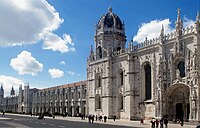
Carrara marble, or Luna marble to the Romans, is a type of white or blue-grey marble popular for use in sculpture and building decor. It has been quarried since Roman times in the mountains just outside the city of Carrara in the province of Massa and Carrara in the Lunigiana, the northernmost tip of modern-day Tuscany, Italy.

The Palace of Mafra, also known as the Palace-Convent of Mafra and the Royal Building of Mafra, is a monumental Baroque and Neoclassical palace-monastery located in Mafra, Portugal, some 28 kilometres from Lisbon. Construction began in 1717 under King John V of Portugal and was completely concluded in 1755.

Portuguese architecture refers to both the architecture of Portugal's modern-day territory in Continental Portugal, the Azores and Madeira, as well as the architectural heritage/patrimony of Portuguese architects and styles throughout the world, particularly in countries formerly part of the Portuguese Empire.

The Cathedral Basilica of Salvador, officially dedicated to the Transfiguration of Christ and named Primatial Cathedral Basilica of the Transfiguration of the Lord is the seat of the Archbishop of the city of Salvador, in the State of Bahia, in Brazil. The Archbishop of Salvador is also ex officioPrimate of Brazil. The structure was built by the Society of Jesus as part of a large Jesuit monastic and educational complex. The current church is the built on the site, and was consecrated in 1654. After the expulsion of the Jesuits from Brazil in 1759 the school and church were transferred to the Archbishopric of Bahia. Archbishop Augusto Álvaro da Silva ordered the demolition of the existing cathedral of Salvador in 1933 to construct a tram line, and elevated the existing Jesuit structure to the status of basilica.
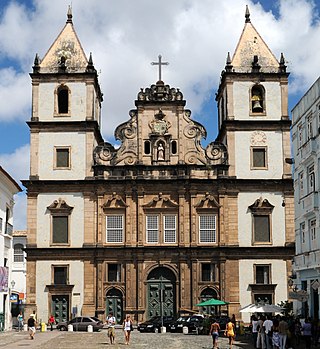
The São Francisco Church and Convent of Salvador is located in the historical centre of Salvador, in the State of Bahia, Brazil. The ornate Church of the Third Order of Saint Francis sits adjacent to the convent. The friars of the Franciscan Order arrived in Salvador in 1587 and constructed a convent and church on the site. This structure was destroyed by the Dutch during the Dutch invasions of Bahia in the next century; Father Vicente das Chagas initiated the current structure in 1686, which was completed in the 18th century. The Franciscan church and convent have the largest number of azulejos, 55,000, of any church in Latin America.

The Historic Center (US) or Centre (UK) of Salvador de Bahia in Brazil, also known as the Pelourinho or Pelo, is a historic neighborhood in western Salvador, Bahia. It was the city's center during the Portuguese colonial period and was named for the whipping post in its central plaza where enslaved people from Africa were publicly beaten as punishment for alleged infractions. The Historic Center is extremely rich in historical monuments dating from the 17th through the 19th centuries.
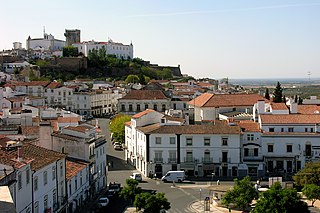
Estremoz is a municipality in Portugal. The population in 2011 was 14,318, in an area of 513.80 km2. The city Estremoz itself had a population of 7,682 in 2001. It is located in the Alentejo region.
The Global Heritage Stone Resource (GHSR) designation seeks international recognition of natural stone resources that have achieved widespread utilisation in human culture. Details of the "Global Heritage Stone Resource" proposal were first provided publicly at the 33rd International Geological Congress in Oslo in August 2008. However, this initiative was suggested in 2007 to enrich an international acknowledgment of famous dimension stones. At the same conference it was agreed to advance the GHSR proposal under the auspices of "Commission C-10 Building Stones and Ornamental Rocks" of the International Association for Engineering Geology and the Environment (IAEG). Since the Oslo conference the designation has also gained support from the International Union of Geological Sciences (IUGS).

The Archbishop's Palace of Salvador is a Roman Catholic residence in Salvador, Bahia, Brazil. It is located on the Praça da Sé in the Pelourinho historical district of the city. The palace was built in the early eighteenth century and is one of the best examples of Portuguese colonial-period civil architecture in Brazil. The Archbishop's Palace was listed as a historic structure by the National Historic and Artistic Heritage Institute in 1938. IPHAN transferred ownership of the palace to the Roman Catholic Archdiocese of São Salvador da Bahia in 2011. The palace sits within the UNESCO World Heritage Site of the Historic Center of Salvador. Part of the structure was converted into a cultural center, the Cultural Center of the Palácio da Sé, which opened in 2020.

The Parish Church of Our Lady of the Rosary is a 17th-century Roman Catholic church in Cachoeira, Bahia, Brazil. Its construction began in the late 17th century and was completed in the 1750s, likely in 1754. The church was listed as a historic structure by National Institute of Historic and Artistic Heritage (IPHAN) in 1939. The church is dedicated to Our Lady of the Rosary and is constructed in the Baroque style.
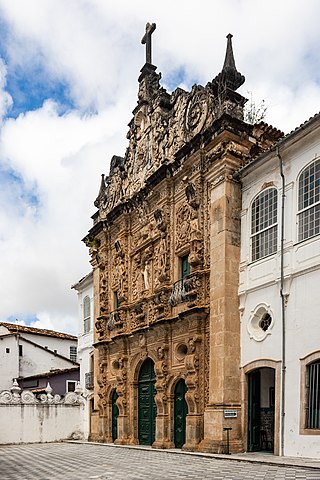
The Church of the Third Order of Saint Francis is an 18th-century Roman Catholic church in Salvador, Bahia, Brazil, and seat of the Third Order of Saint Francis in Brazil. The church is one of the main elements of the Historic Center of Salvador and lies within the UNESCO World Heritage Site of the city. It was listed as a historic structure by National Institute of Historic and Artistic Heritage (IPHAN) in 1941. The church was constructed as an annex to the São Francisco Church and Convent. It is noted for its distinctive Plateresque-style façade, an example unique in Brazil. The writer Jorge Amado called the façade of the Third Order church "magnificent."

The Church and Convent of Our Lady of the Palm is a 17th-century Roman Catholic church in Salvador, Bahia, Brazil. The church is dedicated to Our Lady of the Palm and belongs to the Roman Catholic Archdiocese of São Salvador da Bahia. The church was established in 1830, and expanded to house members of the Order of Discalced Augustinians in Salvador and their missionaries from other Portuguese colonies. The church has a simple façade and a single bell tower. In contrast, the church has a richly decorated interior, with paintings, images, furniture, and religious implements from the 16th and 17th century. The Church and Convent of Our Lady of the Palm was listed as a historic structure by the National Institute of Historic and Artistic Heritage in 1938.

The Church and Convent of Our Lady of Mount Carmel is a 17th-century Roman Catholic church and former convent in Salvador, Bahia, Brazil. The church is dedicated to Our Lady of Mount Carmel. The complex is adjacent to the Church of the Third Order of Mount Carmel. The Church and Convent of Our Lady of Mount Carmel was listed as a historic structure by National Institute of Historic and Artistic Heritage (IPHAN) in 1938 and is part of the Historic Center of Salvador UNESCO World Heritage Site.
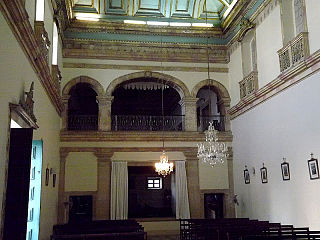
The Church and Convent of Our Lady of the Exile is a 17th-century Roman Catholic church located in Salvador, Bahia, Brazil. The Convent of Our Lady of the Exile was the first female convent constructed in Brazil. Construction of the convent began in 1681 due to the donation of a large fortune of Dona Antônia de Góis, a member of the order. The church building is noted for its elaborate portal in the Rococo style. Its belvedere was the first in Salvador, followed by that of the Convent of Lapa. The high altar has images of Saint Clare, the founder of the order, and Saint Francis; they date to the mid-18th century. The interior of the church was largely renovated in the Neoclassical style in the 19th century. The church was listed as a historic structure by the National Historic and Artistic Heritage Institute in 1938.

Marco da Fundação da Cidade do Salvador is a monument in Salvador, Bahia, Brazil. It is located at the north of the Porto da Barra Beach and directly below the São Diogo Fort. It commemorates the 400th century of the founding of Salvador, and was inaugurated on March 29, 1952. The monument consists of two parts: a limestone pillar, and a mural of azulejos.
Manuel Cardoso de Saldanha was a Portuguese architect and military engineer noted for his work in colonial Brazil. Little is known about his early life in Portugal. His most significant work was the design of the Church of Nossa Senhora da Conceição da Praia. The work was carried out in Portugal and executed by artisans in Salvador, Brazil. Saldanha was sent to Brazil in 1749, travelled to Portugal in 1761, but returned shortly and died in Bahia in 1767.

The colonial architecture of Brazil is defined as the architecture carried out in the current Brazilian territory from 1500, the year of the Portuguese arrival, until its Independence, in 1822.
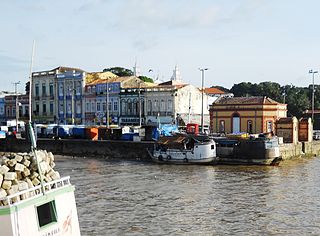
The Dom Frei Caetano Brandão Square, originally called Largo da Sé, is located in the Cidade Velha neighborhood in the Brazilian city of Belém, capital of the state of Pará.

The Ver-o-Peso Complex is an architectural and landscape site located on Boulevard Castilhos França, in the Cidade Velha neighborhood, Belém, capital of Pará. It began to be formed in 1625 with the construction of the Casa de Haver-o-Peso commercial tax office, and in 1977 it was listed as a heritage site by the National Institute of Historic and Artistic Heritage (IPHAN). The complex covers an area of 35,000 m2 and includes several historic buildings in line with the French art nouveau trend of the Belle Époque, such as:
